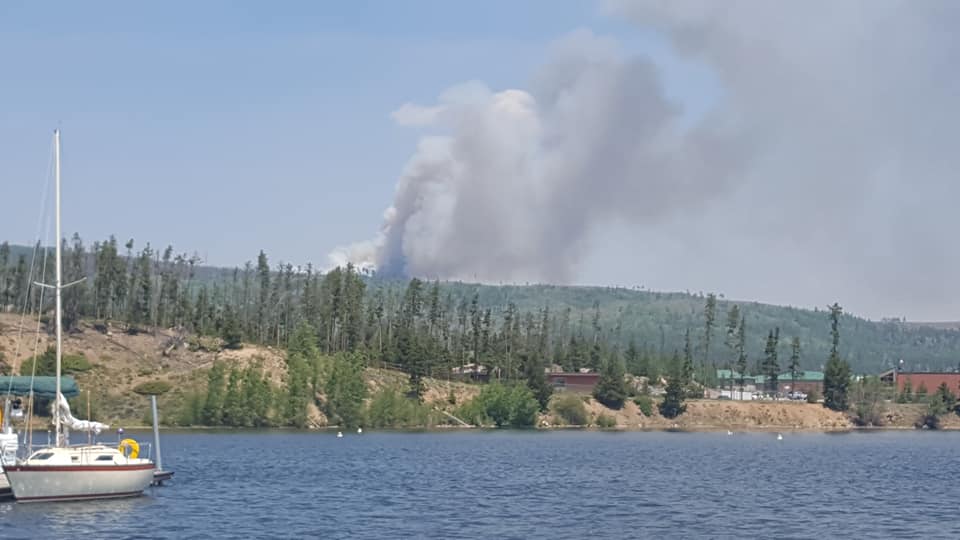
My sister lives in Oak Creek Canyon, near Sedona, Arizona. She recently had to evacuate because of a large wildfire. As she has had to evacuate before, she was more prepared than most. I thought I would copy an email offering fire evacuation tips that she sent to her friends.
For the past thirty years I have lived in an area that is at high risk for wildfire. I have evacuated twice. The first time, I had several hours warning and was only gone for 8 hours. The second time, I had 30 minutes warning and was gone for 10 days. I have been told to ‘prepare to evacuate’ another two times.
I’ve found that when I’m told to evacuate, I don’t think straight. The first time, I evacuated things that were easily replaced and forgot the photo albums.
Now, I follow my list of fire evacuation tips. It also helps to lessen the panic.
If you can’t find an animal, such as an outdoor kitty, sometimes animal rescue groups are allowed in to evacuate pets. During my last evacuation, some homeowners were allowed an escorted visit home (in the back of the sheriff’s car) but only for emergency items that included pets and prescription medications.
A few days after I was evacuated, we knew we wouldn’t be going home soon. As my only means of calling anyone was by cell phone, I called my cell phone company, explained the situation and they generously gave me an additional 150 minutes at no charge.
- Make sure you have adequate insurance before a fire hits.
- Your fire department would be happy to come to your house and make suggestions on what you can do to make your home/neighborhood “firewise”.
- Have an evacuation alert plan for your neighborhood to make sure everyone knows of the evacuation order. I am responsible for calling or alerting three of my neighbors.
- If you live in a high fire-danger area and have been given information critical to evacuation, such as the radio station frequency to tune to for evacuation instructions, keep this in your car or wallet/purse.
- Organize your important things. For example: I keep all my photo albums in one cupboard so I don’t have to collect them from different parts of the house.
- Take photographs of your house and contents. In addition to photographing your home’s exterior, interior, furnishings, etc.
- Photograph the contents of drawers and cupboards. Take close-up photos of things such as CD & book collections. Photograph not only the front of valuable china or pottery – but also the back so the hallmarks are identifiable. Keep the photos in a safe deposit box.
- Insurance adjusters will expect you to prove what you had with either receipts or photographs.
- Exchange cell phone numbers with your family, friends and neighbors.
- Make sure your insurance agent has your cell phone number.
- Carry a list of your prescription medications in your purse or wallet, including the prescription number if you have refills available.
- In my area, when the fire department has asked that when we evacuate the house, we hang a white cloth on the front door. This shows the house is empty and saves precious time for the sheriff or fire department. Ask your fire department if they have a similar plan for your area.
- Also ask if you should leave your house unlocked when you leave.
- Find out how to turn off the gas to your house. If you need a wrench to do this, keep one handy.
- If you have pets, make sure your pet carriers are in a convenient place during fire season so you don’t waste time looking for them.
- It may be several weeks before you are allowed home. Keep this in mind when packing prescription medications, etc.
- Use pillow cases to “grab and run”
- Use bathroom/kitchen trash containers to pack fragile items, wrapping them in towels or clothes first.
- Put similar size artwork face to face and wrap in a blanket. I use my quilt collection to wrap my paintings.
- If you have time, pack a suitcase! You REALLY feel homeless when you are an evacuee with only the clothes on your back.
- Remember things like cosmetics, toiletries, extra shoes. It’s expensive to replace all of this stuff if you’re gone from home for a couple of weeks.
- Time permitting: before evacuating, put a ladder, shovels, garden hose, etc. where they are easily seen.
- Time permitting: Check the outside of the house and move flammable things, such as lawn furniture, away from the house.
- Time permitting: Take down light curtains. Close metal blinds.
- If you have an outdoor kitty that you can’t find, leave a tub of dry food and large bucket of water out for it.
During fire season I keep these in an easy to find place!
- Car keys
- Glasses
- Purse or wallet
- Pets
- Prescription medications
- Cell phone and chargers, AC and DC
- Insurance papers and other important papers
- Bottled water
- Emergency food supplies for you and your pets
- Turn off cooler or air-conditioning
- Turn off gas to house
- Close windows tightly
I do these things first, then if time permits I start collecting things such as photo albums, art work etc. My list includes:
-
Computer
-
Framed photos throughout the house
-
Photo albums
-
Jewelry
-
Family movies, videos etc.
This blog was originally posted July 7th, 2006 by Joanne Hanson. It is good to review fire evacuation tips every spring. Hopefully it won’t be necessary this year since we are coming off a magnificent snow year!


Leave a Reply